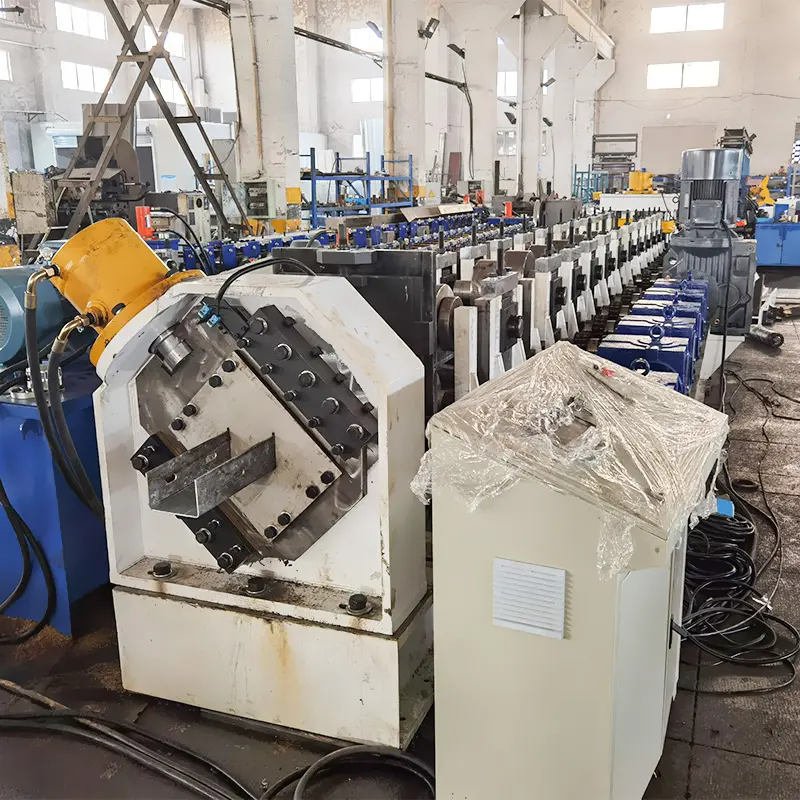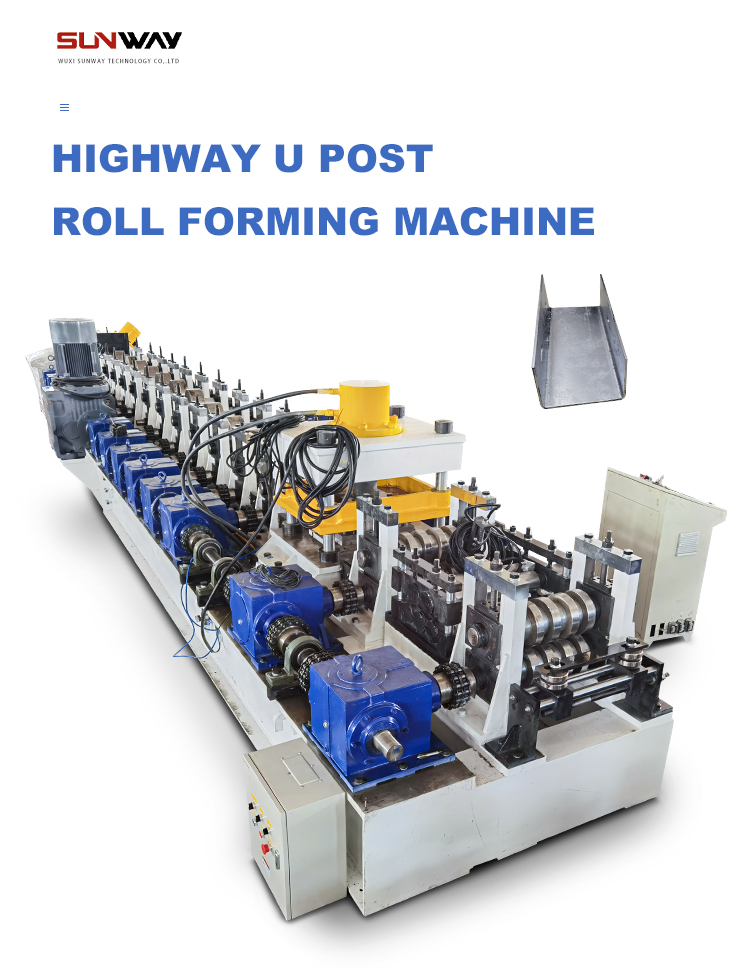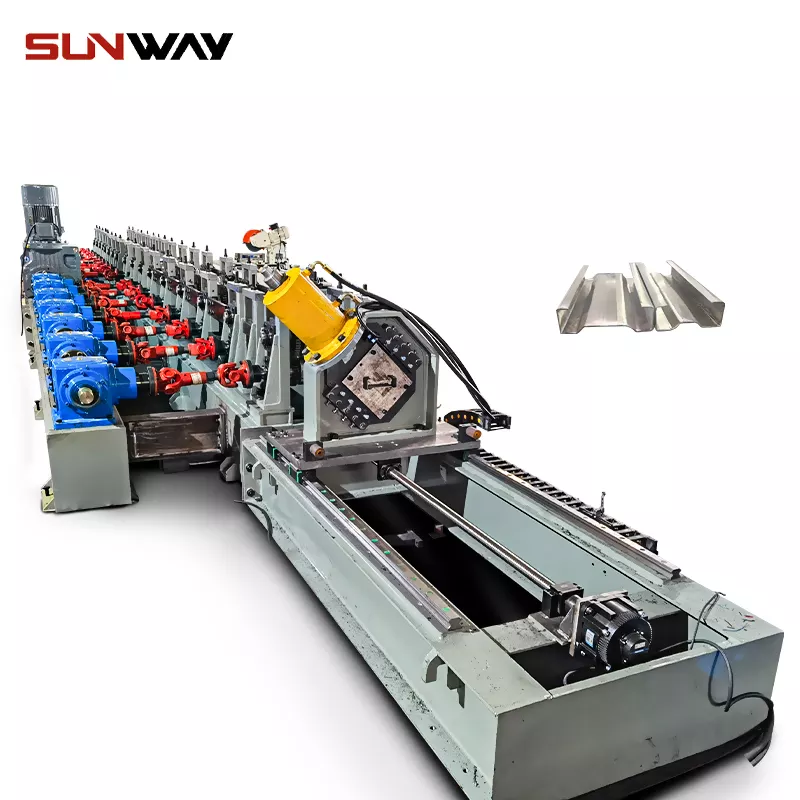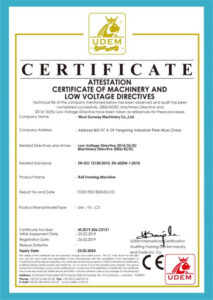Обзор Двухступенчатая рулонная формовка кровельных листов
Двухступенчатые рулонные листогибы предназначены для производства длинных металлических кровельных листов и панелей с ребристыми или гофрированными профилями в высокоскоростном непрерывном процессе.
В отличие от одноступенчатой роликовой формовки, где все стенды расположены на одной линии, двухступенчатые машины имеют формовочные станции, разделенные между верхним и нижним уровнем для создания мужских и женских элементов на кровельных профилях из листового металла. Две стадии формовки позволяют получать более сложные формы по сравнению с одноступенчатыми валковыми формовочными машинами.
В этом руководстве вы узнаете:
- Производство профилей для кровельных листов
- Преимущества двухступенчатой роликовой формовки
- Обзор процесса
- Конфигурации машин
- Этапы формирования
- Технические характеристики и тарифы
- Инструментальная оснастка
- Соображения по конструкции профиля
- Требования к сырью
- Коэффициенты регулировки роликов
- Анализ затрат
- Лучшие производители
- Плюсы и минусы двухступенчатых машин
- Новейшие технологические разработки
Обзор профилей рулонных кровельных листов
Типичные кровельные профили, производимые на двухступенчатых рулонных линиях, включают в себя:
- Гофрированные листы - Синусоидальная форма волны, универсальная и сильная
- Обжимные панели 5 В - Ребра в форме буквы "V", расположенные через равные промежутки
- Листы со стоячим швом - Вертикальные ребра жесткости с рельефными швами
- Трапециевидные листы - Угловые полотна с плоскими фланцами
- Двойные панели замков - Взаимосвязанные мужские и женские ребра
Эти профили обеспечивают прочность конструкции, способность к пролету, устойчивость к атмосферным воздействиям и визуальную привлекательность кровли. Популярными материалами являются оцинкованная, гальваническая и предварительно окрашенная рулонная сталь.
Преимущества двухступенчатой роликовой формовки
Двухступенчатая валковая формовка позволяет:
- Сложные профили - Взаимосвязанные и сочлененные формы
- Высокопрочные панели - Более глубокие мужские и женские ребра
- Более толстый материал - Формованная сталь толщиной до 1,2 мм
- Доступ на нижнюю ступень - Упрощает обслуживание валов
- Независимое управление - Разделение верхних и нижних параметров
- Повышенная жесткость - Повышенная пропускная способность
- Эффективность использования рулонного пространства - Компактная планировка в двух уровнях
Раздельная двухступенчатая конфигурация обеспечивает больший контроль над качеством и гибкость по сравнению с одноступенчатыми машинами.
Обзор процесса формовки валков
При роликовой формовке используется серия прокатных штампов для постепенного придания плоскому металлическому листу нужных профилей:
- Рулонный лист подается через разматыватель в рулонный пресс
- Вальцы нижней ступени предварительно сгибают материал
- Передача листов на верхнюю ступень для окончательного формирования
- Вращающиеся матрицы постепенно сгибают полосу на каждой стойке
- Сформированные выходы кровельных листов для отрезания и сбора
- Непрерывный процесс при высокой скорости производства
Вальцы контролируемо изгибают металл по ширине без изменения толщины материала или потери брака. Непрерывная формовка позволяет эффективно производить большие объемы продукции.

Конфигурации двухступенчатых валковых формовочных машин
Линии двухступенчатой роликовой формовки имеют две основные компоновки:
| Тип | Описание |
|---|---|
| Вертикальный ряд | Нижние и верхние валики расположены по прямой вертикальной линии |
| Бок о бок | Верхняя и нижняя ступени рядом друг с другом |
Компоненты машин
- Разматывание и сматывание катушки
- Стол подачи с прецизионными направляющими
- Станции нижнего и верхнего формовочных валов
- Гидравлический отрезной пресс
- Консоль управления ПЛК для настройки параметров
- Конвейеры или опорные столы
Крупные линии часто оснащаются автоматическими штабелерами, счетчиками и системами пакетирования.
Обзор процесса двухступенчатой формовки
Типичная двухступенчатая вальцовочная машина формует листовой металл, выполняя следующие действия:
- Разбавление - Листовой рулон разматывается и поступает на линию прокатки
- Нивелир - Листы выравниваются и выпрямляются перед формовкой
- Нижняя ступень - Предварительная гибка на нижних станциях
- Высшая ступень - Окончательная гибка и профилирование на верхних станциях
- Резка - Гидравлические торцевые ножницы для резки листов по длине
- Подсчет - Куски автоматически подсчитываются при разрезании
- Укладка - Сформированные листы укладываются на выходной конвейер или столы
Ролики с сервоприводом позволяют регулировать скорость и положение в режиме реального времени для точной формовки.
Технические характеристики машины
| Параметр | Диапазон |
|---|---|
| Скорость формования | 10 - 40 м/мин |
| Мощность привода | 7,5 - 15 кВт |
| Ширина листа | 900 - 1300 мм |
| Толщина металла | 0,35 - 1,2 мм |
| Высота профиля | 20 - 150 мм |
| Вес катушки | До 6 метрических тонн |
| Диаметр ролика | 120 - 220 мм |
Более мощные приводы 15 кВт+ позволяют увеличить скорость производства. Можно работать с рулонами большей ширины - до 1300 мм.
Инструмент, используемый при двухступенчатой роликовой формовке
- Формовочные ролики - Обработанная кованая сталь, индукционная закалка
- Рулоны с подложкой - Оказывать контрфорсную поддержку
- Направляющие валики - Выровняйте полосу по линии
- Пресс для отключения - Лезвия ножниц из закаленной стали
- Быстрая замена - Модульная оснастка для быстрой переналадки
Рулонные материалы с твердостью 700-900 HV предотвращают износ и деформацию. Текстурированные поверхности сцепляются с металлическими листами.
Проектирование кровельного профиля
Ключевые факторы дизайна включают:
- Потребности в производительности - Пролетное строение, погодоустойчивость, ветровая/снежная нагрузка
- Применимые стандарты - Класс кровельного покрытия, размеры, спецификации испытаний
- Механические свойства - Прочность, жесткость на изгиб, сопротивление смятию
- Параметры металлического листа - Толщина, предел текучести, покрытия
- Изготавливаемость - Возможность постепенного сгибания по форме
- Внешний вид - Эстетика, размер и непрерывность узора
3D-моделирование и FEA помогают подтвердить дизайн кровельного профиля перед изготовлением валковой оснастки.
Сырье, используемое для производства кровельных листов
Типичные входы для металлических катушек:
- Стали - Горячая оцинковка, гальвалюм, предварительная окраска
- Толщина - 0,35 - 1,2 мм
- Ширина - До 1300 мм
- Покрытия - Цинк, алюминий-цинк, окрашенные поверхности
- Механические свойства - Предел прочности и текучести
- Поверхность - Ровный матовый цвет с минимальными дефектами
- Плоскость - Не более 5 мм на длине полосы 1,5 м
Высокое качество исходного рулона необходимо для равномерного производства рулонной кровли и устойчивости к коррозии.
Факторы качества при формовке кровельных панелей
Ключевые параметры процесса, контролирующие качество:
- Регулировка рулона - Неправильные зазоры приводят к образованию морщин и дефектов
- Скорость подачи - Превышение скорости увеличивает риск разрыва
- Поддержка полос - Недостаточная поддержка приводит к провисанию листов
- Параллельность валков - Минимизирует колебания толщины профилей
- Смазка - Предотвращает истирание между точками контакта
- Износ валков - Вызывает отклонения в размерах и качестве
- Выравнивание полос - Предотвращает перекосы и искажения
Мониторинг в режиме реального времени и автоматическая обратная связь сводят к минимуму количество дефектов и простоев.
Анализ темпов производства
| Параметр | Типичные тарифы |
|---|---|
| Скорость линии | 10 - 40 м/мин |
| Выход | 400 - 1600 м/час |
| Штук в смену | 160 - 640 листов |
- Узкая ширина менее 1 метра обеспечивает максимальную скорость.
- Большая высота профиля замедляет скорость формования
- Более крупные ребристые панели имеют меньшую линейную производительность
Автоматические укладчики могут упаковывать более 1000 листов в час.
Анализ затрат по сравнению с другими методами
| Процесс | Стоимость оборудования | Эффективность использования материалов | Труд | Стоимость за штуку |
|---|---|---|---|---|
| Профилирование | $$$ | 90-95% | Низкий | $ |
| Формование на листогибочном прессе | $$ | 50-70% | Высокая | $$ |
| Сборка | $ | 80-90% | Высокая | $$ |
Несмотря на более высокие первоначальные инвестиции, валковая формовка обеспечивает более быстрое производство с меньшим количеством отходов материала по сравнению с альтернативными процессами.
Ведущие производители двухступенчатых машин
| Компания | Расположение |
|---|---|
| AIMIL | Индия |
| BMW | Китай |
| Гаспарини | Италия |
| Metform | США |
| Педерсен | Дания |
| Rotoform | Венгрия |
| Шриджи | Индия |
Эти фирмы предлагают интегрированные линии, начиная с производства рулонов и заканчивая отрезанием профилей и укладкой в штабель.

Преимущества двухступенчатой роликовой формовки
- Непрерывное высокоскоростное производство до 40 м/мин
- Позволяет создавать сложные взаимосвязанные кровельные профили
- Выход материала до 95% по сравнению со штамповкой
- Постоянное качество и повторяющиеся допуски
- Идеально подходит для длительного крупносерийного производства
- Автоматизированный процесс сокращает трудозатраты
- Более безопасное закрытое оборудование по сравнению с открытыми машинами
- Диапазон размеров от компактных до тяжелых
- Требуется минимальное обслуживание инструмента
Двухступенчатая система разделения обеспечивает преимущества по сравнению с одноступенчатыми валковыми формовочными машинами.
Ограничения двухступенчатых валковых формовочных машин
- Более высокие первоначальные капитальные вложения
- Не подходит для короткого или малосерийного производства
- Ограниченная гибкость после настройки инструментов для профиля
- Ограничения по размерам в пределах габаритов машины
- После формовки требуется дополнительная отделка
- Для регулировки центровки валов требуются специальные навыки
- Время, необходимое для проектирования оснастки и механической обработки
- Может возникнуть деформация панели для консервирования масла
- Сложность соблюдения очень жестких допусков
Для кровельного покрытия из листового металла длиной менее 1000 метров лучше использовать альтернативные методы.
Последние достижения в области двухступенчатой технологии
- Быстросменная оснастка - Сокращение времени простоя при замене профилей
- Поточная перфорация - Пробивает регистрационные отверстия во время формовки
- Системы технического зрения - Оптический контроль дефектов в процессе производства
- Сканирование рулонов - Обнаружение проблем с выравниванием/зазором роликов
- Модернизация системы безопасности - Дополнительная защита, цепи электронного останова
- Автоматизация обработки - Сокращение ручного штабелирования листов
- Модернизация сервоприводов - Улучшает контроль скорости и положения
- Программное обеспечение для проектирования валов - Цифровое моделирование процесса формования
Эти инновации направлены на дальнейшее повышение качества, гибкости и производительности при производстве рулонных кровельных материалов.
Вывод
Двухступенчатая рулонная штамповка обеспечивает эффективный непрерывный процесс высокоскоростного производства металлических кровельных профилей, позволяя создавать сложные конструкции с перекрещивающимися швами. При правильном проектировании и поставке качественного рулонного материала машины могут производить ребристые и гофрированные панели с отличным постоянством и долговечностью в соответствии с архитектурными требованиями.
Несмотря на то, что двухступенчатая рулонная штамповка требует больших первоначальных капитальных затрат по сравнению с другими методами, ее высокая производительность, минимальные отходы материала и автоматизированный характер делают ее оптимальной технологией для длительного производства, когда требуются тысячи кровельных листов.

Часто задаваемые вопросы
Здесь представлены ответы на некоторые часто задаваемые вопросы:
Каковы основные преимущества двухступенчатой роликовой формовки?
Основными преимуществами являются возможность изготовления взаимосвязанных и сложных профилей, возможность работы с более толстыми материалами, независимое управление и доступность с нижней ступени.
Какая толщина листового металла может быть использована для двухступенчатой роликовой формовки?
Стандартные станки рассчитаны на толщину металла от 0,35 до 1,2 мм. При толщине свыше 1,2 мм возникают дополнительные трудности.
Какие кровельные профили можно производить на двухступенчатых линиях?
Среди распространенных профилей - гофрированные, 5V гофры, стоячий шов, трапециевидные и двухзамковые панели.
Насколько короткими могут быть листы, изготовленные методом двухступенчатой роликовой формовки?
Хотя это и не оптимально, можно производить листы длиной до 3 м, но при этом могут возникать разрывы кромок.
Какие допуски возможны для двухступенчатых рулонных кровельных панелей?
Стандартный допуск составляет +/- 1,0 мм, но современные станки с прецизионными валами и направляющими могут достигать точности +/- 0,5 мм.
Сколько времени требуется для переналадки профильной оснастки на двухступенчатых линиях?
Благодаря быстросменной модульной оснастке типичное время переналадки различных профилей кровельных листов составляет 2-5 часов.
Какие параметры делают двухступенчатую рулонную формовку экономически выгодной?
Из-за более высоких первоначальных затрат для оправдания инвестиций в двухступенчатые линии обычно требуются объемы производства свыше 500 000 м/год.
Какие навыки необходимы для безопасной работы на двухступенчатом валковом оборудовании?
Требуются способности к механике, знание электрики и систем управления, умение устранять неисправности и специальное обучение работе с машинами.


